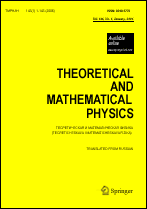|
Quasi-Relativism, the Narrow-Gap Property, and Forced Electron Dynamics in Solids
B. S. Pavlovab, A. A. Pokrovskia, A. V. Strepetovc
a V. A. Fock Institute of Physics, Saint-Petersburg State University
b University of Auckland
c Saint-Petersburg State University of Aerospace Instrumentation
Abstract:
Narrow-gap semiconductors, used in quantum network engineering, are characterized by small effective electron masses on the Fermi level and hence by high electron mobility in the lattice. We construct an explicitly solvable model that clarifies one possible mechanism for small effective masses to appear. Another mathematical model constructed here describes a possible mechanism for using a traveling wave to control an alternating quantum current in a one-dimensional lattice.
Citation:
B. S. Pavlov, A. A. Pokrovski, A. V. Strepetov, “Quasi-Relativism, the Narrow-Gap Property, and Forced Electron Dynamics in Solids”, TMF, 131:1 (2002), 72–83; Theoret. and Math. Phys., 131:1 (2002), 506–515
Linking options:
https://www.mathnet.ru/eng/tmf1951https://doi.org/10.4213/tmf1951 https://www.mathnet.ru/eng/tmf/v131/i1/p72
|


|




 Contact us:
Contact us: Terms of Use
Terms of Use
 Registration to the website
Registration to the website Logotypes
Logotypes








 Citation in format
Citation in format 